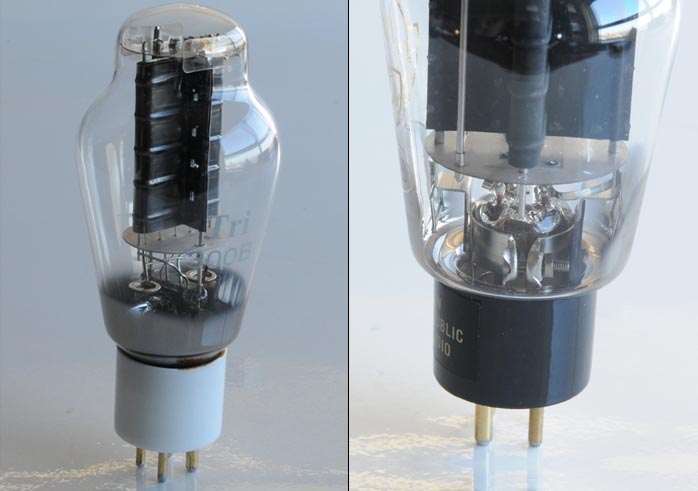|
|
|
|
|
This review page is supported in part by the sponsors whose ad banners are displayed below
|
|
 |
|
Let's start by comparing the direct-heated triodes we had at our disposal. Unpeeled from their boxes, we had our first surprise. Some of the tubes stored in their original boxes had cases of metal rash. Not all pins were gilded. Some used simple plated copper that had oxidized green. The AVVT was most prone to this. Fortunately we had a set of Xtreme AV Quicksilver contact enhancer which comes with a tube of DeoxIT D100L contact cleaner. We did not apply the Quicksilver itself as that will be the subject of another review if time allows. The DeoxIT alone worked miracles and soon all pins looked new.
|
|
|
|
|
|
|
 |
|
As sonic yardstick we used the Tri-branded 300Bs supplied with the amplifier. Their choice of course is a balance between quality and price but considering the other components used in the amplifier, cost was second. The Tri tube is a relabeled Chinese Shuguang also available as Golden Dragon and, as we saw later, Audio Note. The complete system for this test comprised our trusted CEC TL5100 spinner connected via ASI LiveLine to the Audio Note DAC whence, via another LiveLine, it went to the Tri integrated and from there via bi-wired Nanotec GS #79 and GS #79 nano 3 to our Avantgarde Duo Omega horns. All power cables were LessLoss DFPC and the room itself is tuned with ASI resonators and Sugar Cubes.
|
|
|
 |
|
The music from the system is characterized by openness and clarity. At times powerful high vocals get edgy and sharp. Bass is controlled but short on extension. Overall, the system’s sound was involving enough to bond listener to music when the latter consisted of small ensembles not too closely miked. With larger groups or full orchestras, this system could not fully scale up to accommodate realistic size.
|
|
 |
|
|
Tri-labeled Shuguang | KR Audio
|
|
When we swapped the Tri for the identical looking Audio Note tube after an hour of warm-up before listening, there was no surprise. These tubes were stock with our Meishu and had clocked considerable hours without being so worn as to be discarded. Contrary to wine, tube aging reduces potency or output power which can manifest as a poorly matched pair. Our Audio Note tubes needed somewhat less signal attenuation to produce the same level as the Tri, i.e. showed some power loss from wear but otherwise produced the same sonic signature of minor bass leanness with overall clearness. The only real difference was that high-energy vocals had lost their sharp edge. These older tubes rolled these notes off nicely without sacrificing the clarity. These Tri/Audio Note Chinese valves are capable of providing that relaxed, friendly and stress-free sound typically associated with 300Bs.
|
|
 |
|
Swapping tubes and in particular tubes of the direct-heated sort where the cathode is the heater shouldn't be done carelessly as mishandling can be expensive not only in replacing a tube but blowing a transformer our other significant amplifier part. A 300B has four dissimilar pins. The two thicker ones feed the filament, the thinner ones the grid and anode. When playing around with tubes of this kind, double check correct pin alignment. Not all tube sockets are alike. Some welcome any pin diameter in every hole. Speaking of sockets, the Tri TRV-A300SE uses recessed ones. While the appearance is great, with only the glass envelope visible, it makes tube removal a delicate action since the glass envelope is merely glued to the base. How strong is the glue? If not sufficiently, you might damage or break a wire that connects to a pin. With recessed sockets, always attempt to pull out the tube as vertical as possible to avoid wiggling. On standard sockets, remove by the base, not the glass to minimize shear and torque on the glue connection.
|
|
 |
|
|
After a generous cool-down period, we inserted a pair of Slovak JJ/Tesla which made the former feel light and brittle by comparison. The JJ is heavier not only due to its ceramic base but also because the glass bulb is thicker and taller. The extra height is necessary for the top cooling fins. These tubes too had more than 500 hours on them to which we added an extra hour before listening. We bought these because they have more bass extension than standard 300Bs like Shuguangs. And the JJ still did. This tube makes it possible to enjoy a full orchestra with all its dynamics. The sound is as robust as the tube's build, without being a 300B-on-steroids 320B XLS variant. With the enhanced bass capabilities and perhaps due also to a heavier construction that damps microphonics, the ability to transmit minute detail has suffered. Nevertheless, the JJ is a tube that makes bathing in music very enjoyable for hours.
|
|
|
|
|
 |
 |
|
 |
|
|
|
|
|
|
|